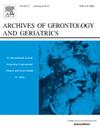Associations of protein intake with the risk of fractures: A prospective cohort study of UK biobank participants
IF 3.5
3区 医学
Q2 GERIATRICS & GERONTOLOGY
引用次数: 0
Abstract
Purpose
To evaluate the associations between protein intake and fractures risk in a large population-based cohort.
Methods
We conducted a prospective population-based study of UK Biobank. Participants aged 40–69 who completed the Oxford WebQ dietary questionnaire at least once were included. Exposures were percentage of energy provided by protein and its components (animal and vegetable protein). Participants were categorized into quintiles based on these exposures. The primary outcome was composite fracture, and secondary outcomes included osteoporotic and hip fractures, defined by ICD-10 codes. We used Cox proportional hazard models and restricted cubic splines (RCS) to assess the association between exposure and outcomes, as well as their dose-response relationships.
Results
This study included 132,807 participants (mean [SD] age, 56.8 [8.0] years; 68,769 [51.8 %] female). During a median follow-up of 12.4 years, 6,673 composite fractures, 4,496 osteoporotic fractures and 930 hip fractures occurred. Regarding protein intake, compared to the lowest quintile (Q1), individuals in the highest quintile (Q5) had significantly lower risks of composite fracture (HR 0.82, 95 % CI 0.75–0.90), osteoporotic fracture (HR 0.81, 95 % CI 0.72–0.91) and hip fracture (HR 0.63, 95 % CI 0.49–0.82). Similar results were observed for animal and vegetable protein intake. RCS revealed a negative linear dose-response relationship between protein intake and fractures risk.
Conclusion
Increased protein intake can significantly reduce the risk of fractures and may serve as an important dietary strategy for promoting bone health.

求助全文
约1分钟内获得全文
求助全文
来源期刊
CiteScore
7.30
自引率
5.00%
发文量
198
审稿时长
16 days
期刊介绍:
Archives of Gerontology and Geriatrics provides a medium for the publication of papers from the fields of experimental gerontology and clinical and social geriatrics. The principal aim of the journal is to facilitate the exchange of information between specialists in these three fields of gerontological research. Experimental papers dealing with the basic mechanisms of aging at molecular, cellular, tissue or organ levels will be published.
Clinical papers will be accepted if they provide sufficiently new information or are of fundamental importance for the knowledge of human aging. Purely descriptive clinical papers will be accepted only if the results permit further interpretation. Papers dealing with anti-aging pharmacological preparations in humans are welcome. Papers on the social aspects of geriatrics will be accepted if they are of general interest regarding the epidemiology of aging and the efficiency and working methods of the social organizations for the health care of the elderly.

 求助内容:
求助内容: 应助结果提醒方式:
应助结果提醒方式:


